您好,登錄后才能下訂單哦!
您好,登錄后才能下訂單哦!
| 準備 |
col empno for 9999; col ename for a10; col job for a10; col mgr for 9999; col hiredate for a12; col sal for 9999; col comm for 9999; col deptno for 99; col tname for a40; set pagesize 80; |
--創建新表xxx_emp,復制emp表中的結構,同時復制emp表的所有數據 create table xxx_emp as select * from emp; |
回顧SQL92/99標準的四大類
(1)DML(數據操縱語言):select,insert,update,delete
(2)DDL(數據定義語言):create table,alter table,drop table,truncate table
(3)DCL(數據控制語言):grant select any table to scott/revoke select any table from scott
(4)TCL(事務控制語言):commit,rollback,savepoint to 回滾點
向emp表中插入一條記錄(方式一:按表默認結構順序)insert into 表名 values ...語法
insert into emp values(1111,'JACK','IT',7788,sysdate,1000,100,40);
向emp表中插入一條記錄(方式二:按自定義順序)insert into 表名(列名) values ...語法
insert into emp(ENAME,EMPNO,JOB,MGR,HIREDATE,SAL,COMM,DEPTNO)
values('MARRY',2222,'IT',7788,sysdate,1000,100,40);向emp表中插入NULL值(方式一:采用顯示插入NULL值)
insert into emp values(3333,'SISI','IT',7788,sysdate,1000,NULL,40);
向emp表中插入NULL值 (方式二:采用隱式插入NULL值),前提是所插入的字段允許插入NULL值
insert into emp(ENAME,EMPNO,JOB,MGR,HIREDATE,SAL,DEPTNO)
values('SOSO',4444,'IT',7788,sysdate,1000,40);【&占位符應用于insert】使用&占位符,動態輸入值,&可以運用在任何一個DML語句中,在values子句中使用,例如:'&ename'和&sal
insert into emp values(&empno,'&ename','&job',&mgr,&hiredate,&sal,&comm,&xxxxxxxx);
注意:&是sqlplus工具提供的占位符,如果是字符串或日期型要加''符,數值型無需加''符
【&占位符應用于select的表名】使用&占位符,動態輸入值,&可以運用在任何一個DML語句中,在from子句中使用
select * from &table;
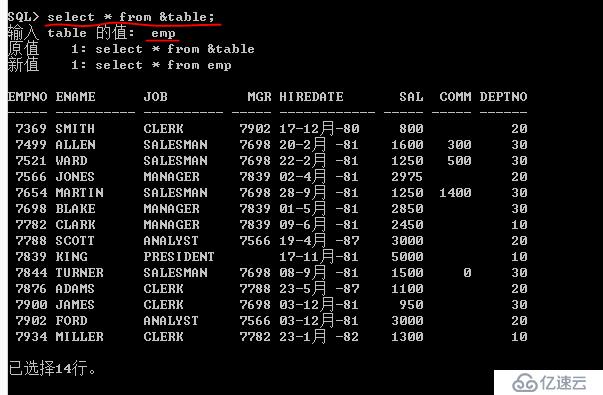
【&占位符應用于select的列名】使用&占位符,動態輸入值,&可以運用在任何一個DML語句中,在select子句中使用
select empno,ename,&colname from emp;
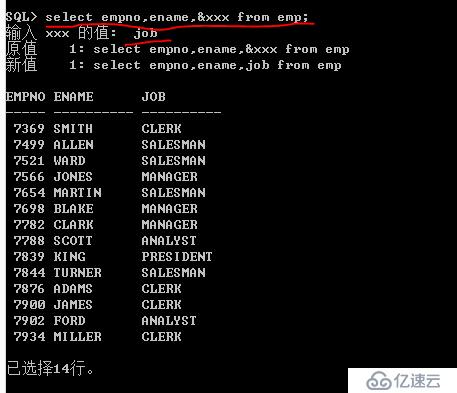
【&占位符應用于where】使用&占位符,動態輸入值,&可以運用在任何一個DML語句中,在where子句中使用
select * from emp where sal > &money;
【&占位符應用于group by和having】使用&占位符,動態輸入值,&可以運用在任何一個DML語句中,在group by 和 having子句中使用
select deptno,avg(sal) from emp group by &deptno having avg(sal) > &money;
刪除emp表中的所有記錄
delete from emp;
將xxx_emp表中所有20號部門的員工,復制到emp表中,批量插入,insert into 表名 select ...語法
insert into emp select * from xxx_emp where deptno=20;
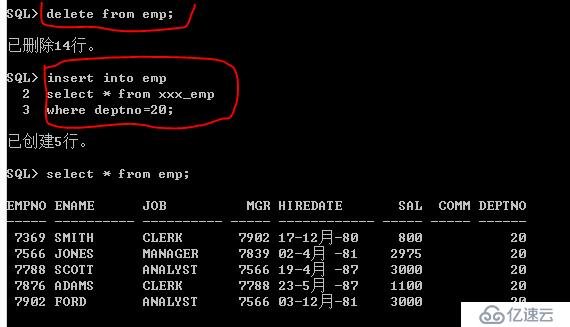
將'SMITH'的工資增加20%
update emp set sal=sal*1.2 where ename = upper('smith');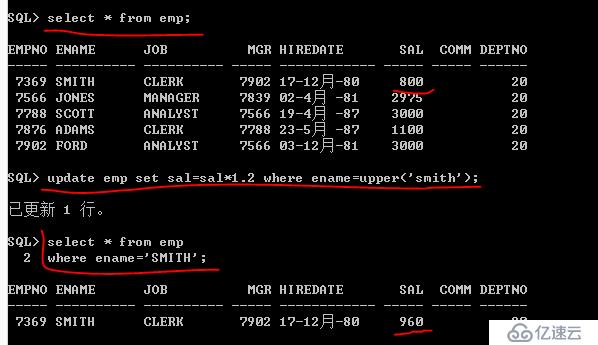
將'SMITH'的工資設置為20號部門的平均工資,這是一個條件未知的事物,優先考慮子查詢
第一:20號部門的平均工資
select avg(sal) from emp where deptno=20;
第二:將'SMITH'的工資設置為2207
update emp set sal=2207 where ename = 'SMITH';
子查詢:
update emp set sal = ( select avg(sal) from emp where deptno=20 ) where ename = 'SMITH';
刪除工資比所有部門平均工資都低的員工,這是一個條件未知的事物,優先考慮子查詢
第一:查詢所有部門的平均工資
select avg(sal) from emp group by deptno;
第二:刪除工資比(*,*,*)都低的員工
delete from emp where sal<all(*,*,*);
子查詢:
delete from emp where sal < all( select avg(sal) from emp group by deptno );
刪除無傭金的員工
delete from emp where comm is null;
將emp表丟入回收站,drop table 表名
drop table emp;
從回收站將emp表閃回,flashback table 表名 to before drop
flashback table emp to before drop;
查詢回收站,show recyclebin
show recyclebin;
清空回收站,purge recyclebin
purge recyclebin;
使用關鍵字purge,徹底刪除emp表,即不會將emp表丟入回收站,永久刪除emp表,drop table 表名 purge
drop table emp purge;
依據xxx_emp表結構,創建emp表的結構,但不會插入數據
create table emp as select * from xxx_emp where 1<>1;
create table emp(empno,ename) as select empno,ename from xxx_emp where 1=2;
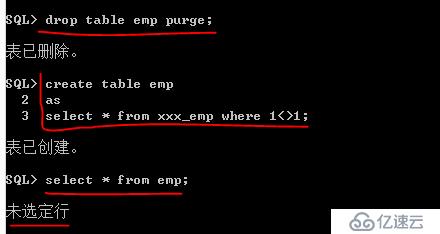
創建emp表,復制xxx_emp表中的結構,同時復制xxx_emp表的所有數據
create table emp as select * from xxx_emp where 1=1;
注意:where不寫的話,默認為true
將emp截斷,再自動創建emp表,truncate table 表名
truncate table emp;
向emp表,批量插入來自xxx_emp表中部門號為20的員工信息,只包括empno,ename,job,sal字段
insert into emp(empno,ename,job,sal) select empno,ename,job,sal from xxx_emp where deptno=20;
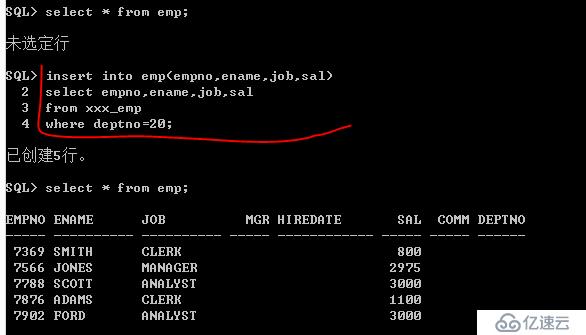
向emp表(只含有empno和ename字段),批量插入xxx_emp表中部門號為20的員工信息
insert into emp(empno,ename) select empno,ename from xxx_emp where deptno=20;
| drop table 和 truncate table 和 delete from 區別: |
drop table 1)屬于DDL 2)不可回滾 3)不可帶where 4)表內容和結構刪除 5)刪除速度快 |
truncate table 1)屬于DDL 2)不可回滾 3)不可帶where 4)表內容刪除 5)刪除速度快 |
delete from 1)屬于DML 2)可回滾 3)可帶where 4)表結構在,表內容要看where執行的情況 5)刪除速度慢,需要逐行刪除 |
免責聲明:本站發布的內容(圖片、視頻和文字)以原創、轉載和分享為主,文章觀點不代表本網站立場,如果涉及侵權請聯系站長郵箱:is@yisu.com進行舉報,并提供相關證據,一經查實,將立刻刪除涉嫌侵權內容。